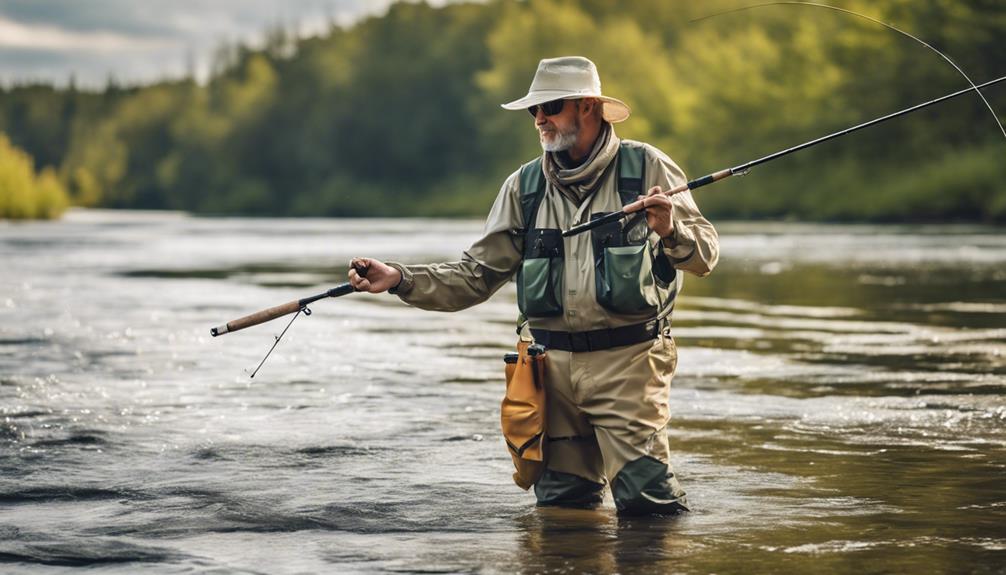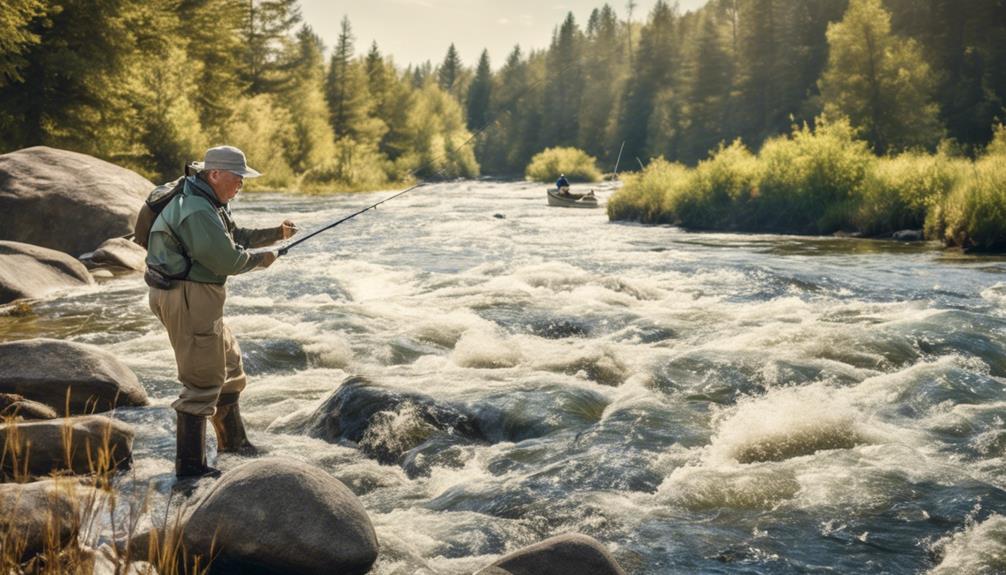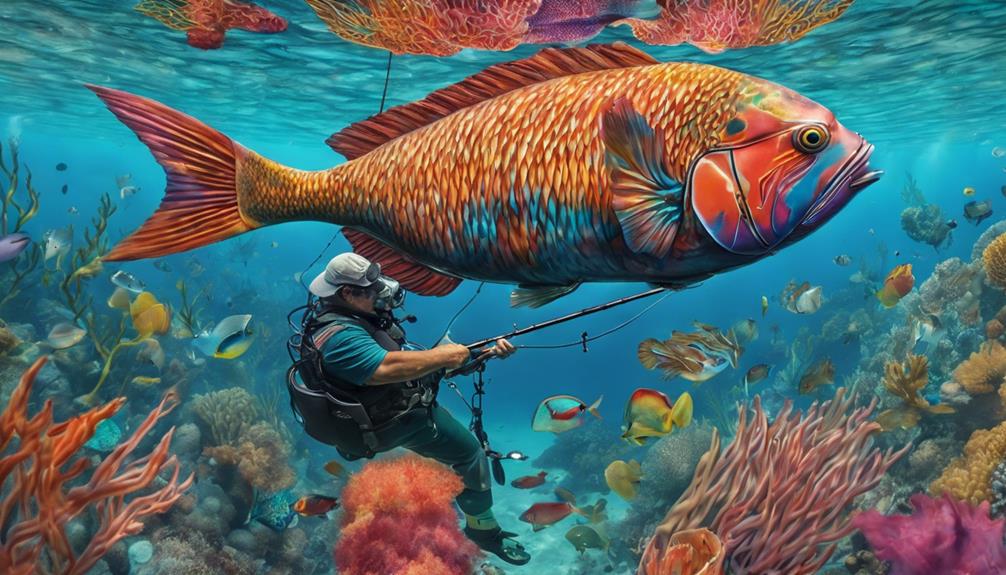When it comes to trout fishing, the gear you choose can make or break your day on the water. Imagine effortlessly casting your line, the anticipation building as you feel a tug, and then, success. But how do you ensure that every fishing trip ends with a catch worth boasting about?
The key lies in selecting the best gear tailored for trout fishing. Let's explore the essential tools and equipment that can elevate your trout angling experience to new heights.
Rods for Trout Fishing
When trout fishing, selecting a rod with the right length and action is crucial for maximizing your chances of a successful catch. For fly fishing, a rod with a lighter weight and more flexible action is ideal. This allows for delicate presentations of flies and better control over the line, crucial for enticing trout in various water conditions. In contrast, when using spinning tackle for trout fishing, a rod with slightly more weight and a faster action is preferred. This helps in casting lures accurately and provides the strength needed to hook and reel in trout more effectively.
Fly fishing rods typically range from 7 to 9 feet in length, offering the versatility needed for different casting techniques and water environments. The action of the rod, whether it's slow, medium, or fast, determines how much the rod flexes and where the power is distributed along its length. A slow action rod is more forgiving, making it suitable for beginners, while a fast action rod provides greater sensitivity and power for experienced anglers seeking longer casts and better control.
On the other hand, spinning rods for trout fishing are usually shorter, ranging from 5 to 7 feet, to allow for more accurate and controlled casting with lures. The faster action of spinning rods helps in setting the hook firmly in the trout's mouth, especially when dealing with quick strikes or fishing in areas with obstacles where immediate control is necessary. By choosing the right rod for your preferred trout fishing method, you can significantly improve your chances of a successful and enjoyable fishing experience.
Reels for Trout Angling
Selecting the right reel is essential for successful trout angling, ensuring smooth line retrieval and effective control during the fight. When choosing a reel for trout fishing, consider the drag system, which controls the amount of pressure the fish feels when it pulls the line. Quality drag systems help prevent line breakage and tire out the trout efficiently during the battle. Regular maintenance is crucial to keep the drag system functioning smoothly, so make sure to clean and lubricate your reel as needed to avoid malfunctions during crucial moments.
Another important factor to consider is the gear ratio of the reel. A higher gear ratio allows for quicker line retrieval, which can be beneficial when trying to reel in a fast-moving trout or when employing certain casting techniques. Understanding gear ratios can enhance your angling experience by providing you with the right tools to adapt to different fishing conditions effectively.
When it comes to casting techniques, your reel plays a significant role in your ability to control the line and accurately place your bait or lure where the trout are lurking. A well-maintained reel with a suitable gear ratio can improve your casting accuracy and distance, giving you an edge when targeting elusive trout. By selecting a reel with a reliable drag system, maintaining it properly, and understanding gear ratios for different angling scenarios, you can elevate your trout fishing game and increase your chances of landing that prized catch.
Lines for Trout Fishing
To maximize your success in trout fishing, choosing the right line is crucial for effectively presenting your bait or lure to these elusive fish. The line you select can greatly impact your knot tying techniques and casting accuracy. Here are some key points to consider when choosing the best line for trout fishing:
- Line Weight: Match your line weight to the size of the trout you're targeting. Lighter lines work well for smaller trout in clear water, while heavier lines are better for larger fish or in more turbulent conditions.
- Floating vs. Sinking Lines: Consider the water conditions when deciding between a floating or sinking line. Floating lines are ideal for topwater presentations, while sinking lines are better for getting your bait deeper in the water column.
- Braided Lines: Braided lines offer excellent sensitivity, making it easier to detect subtle bites from trout. They're also more durable and have less stretch compared to monofilament lines.
- Fluorocarbon Lines: Fluorocarbon lines are nearly invisible underwater, making them a great choice for clear water conditions. They sink faster than monofilament, helping your bait reach the desired depth quickly.
Selecting the right line based on water conditions and fishing strategies can significantly improve your chances of landing that prized trout. Experiment with different lines to see which one works best for your fishing style and the specific conditions you encounter.
Lures for Trout Fishing
For successful trout fishing, choosing the right lures is essential to enticing these elusive fish to bite. When it comes to trout fishing, two types of lures stand out: fly fishing and spinner lures.
Fly fishing lures are a staple in any trout angler's arsenal. These lures mimic insects or other small creatures that trout feed on. The art of fly fishing lies in presenting the fly in a natural and enticing manner, often requiring delicate casts and precise movements to imitate the behavior of real insects on the water's surface. Fly fishing lures come in a variety of sizes, colors, and patterns to match the specific insects present in the trout's environment.
On the other hand, spinner lures are excellent for covering more water and attracting aggressive trout. These lures have a spinning blade that creates vibrations and flashes underwater, grabbing the attention of nearby trout. Spinner lures come in different blade shapes and sizes, each producing a unique underwater movement and reflection that can trigger strikes from curious or hungry trout.
Whether you prefer the finesse of fly fishing or the action of spinner lures, selecting the right lures for trout fishing can significantly increase your chances of a successful day on the water. Experiment with different types and sizes to see what works best in your local trout waters.
Baits for Trout Fishing
When targeting trout, utilizing natural baits can be highly effective in enticing bites from these selective fish. Understanding bait selection and fish behavior is crucial for a successful trout fishing experience. Trout are known for their feeding habits, often being selective about what they consume.
To optimize your chances of a good catch, consider the following key points:
- Match the Hatch: Trout are more likely to bite on baits that resemble the insects or small fish they typically feed on. Choose baits that closely mimic the local aquatic life to increase your chances of success.
- Use Live Bait: Live bait such as worms, minnows, or insects can be incredibly enticing to trout. The natural movement and scent of live bait make it hard for trout to resist.
- Experiment with PowerBait: PowerBait is a popular choice among trout anglers. Its doughy texture allows it to float above the lake bottom, making it more visible and attractive to trout.
- Consider Artificial Baits: While natural baits are effective, artificial baits like spinners, spoons, or soft plastic lures can also yield great results. Experiment with different colors and sizes to see what works best based on trout activity and water conditions.
Nets for Trout Catching
Selecting the right net is essential for efficiently landing trout during your fishing adventures. When it comes to landing technique and fish handling, having a net with a soft mesh material is crucial. The soft mesh helps prevent damaging the trout's delicate scales and fins, ensuring a safe landing. Opt for a net with a shallow bag to easily scoop up the trout without causing unnecessary stress.
For those practicing catch and release to support conservation efforts, using a rubber net is highly recommended. Rubber nets aren't only gentle on the fish but also reduce the likelihood of removing their protective slime layer, which is vital for their health. This ensures that the trout you release have the best chance of survival after being caught.
When handling trout with a net, it's important to minimize the time they spend out of the water. Always keep the trout in the water as much as possible, even when using a net for landing. Avoid lifting the fish too high off the water and handle them with wet hands to prevent removing their protective slime.
Clothing for Trout Fishing

Gear up in appropriate clothing to ensure comfort and protection during your trout fishing excursions. When gearing up for a successful day of trout fishing, your clothing choices are just as important as your fishing gear. Here are some key aspects to consider:
- Wading essentials, proper footwear: Invest in a good pair of waders to keep dry and comfortable while wading through streams or rivers. Proper footwear is crucial for maintaining traction on slippery rocks and uneven riverbeds.
- Sun protection, clothing options: Protect yourself from the sun's harmful rays by wearing clothing that offers UPF protection. Lightweight, long-sleeved shirts and pants can shield your skin without causing you to overheat. Don't forget a wide-brimmed hat and polarized sunglasses to protect your face and eyes.
- Layering for changing weather: Weather conditions can vary throughout the day, especially in mountainous regions where trout fishing often takes place. Dressing in layers allows you to adjust your clothing to stay comfortable as temperatures fluctuate.
- Quick-drying materials: Opt for clothing made from quick-drying fabrics to help manage moisture and sweat. This will keep you dry and prevent chafing, especially if you plan on spending long hours on the water.
Accessories for Trout Angling
Enhance your trout angling experience with essential accessories designed to improve your fishing success and efficiency. When it comes to successful trout fishing, tackle organization is key. Invest in a sturdy tackle box with compartments to keep your lures, hooks, weights, and other gear neatly organized. This won't only save you time rummaging through a messy bag but also ensure that you have the right tackle readily available when needed.
Another crucial accessory for trout fishing is a fly-tying kit. Being able to create your own flies allows you to customize them to match the hatch or mimic local insects, giving you a competitive edge. A fly-tying kit typically includes a vise, scissors, thread, feathers, and other materials needed to craft effective flies. By tying your own flies, you can save money in the long run and have a sense of pride in using a lure you created yourself.
Additionally, consider investing in a fly patch or holder to keep your flies secure and easily accessible while on the water. This accessory can prevent your flies from getting lost or damaged, ensuring they remain in top condition for your next cast. By incorporating these accessories into your trout angling arsenal, you'll be better equipped to handle various fishing situations and increase your chances of landing that prized trout.
Frequently Asked Questions
How Important Is It to Match the Size of the Lure to the Size of the Trout You Are Targeting?
When targeting trout, matching lure size to the fish you're after is crucial. Lure selection plays a big role in enticing trout to bite. By choosing the right size, you can mimic natural prey and increase your chances of success.
Trout feeding habits and water temperature also influence their preferences. Pay attention to these factors when selecting your gear to maximize your chances of a successful fishing trip.
Are There Any Specific Types of Bait That Work Best for Catching Trout in Fast-Moving Rivers?
When fishing for trout in fast-moving rivers, consider using fly fishing techniques and river fishing tactics. Trout in these waters are usually feeding on insects near the surface, so the best bait options include dry flies, nymphs, and streamers. These mimic the natural food sources of the trout, increasing your chances of a successful catch.
Experiment with different bait sizes and colors to see what works best in the specific river conditions.
What Are Some Considerations to Keep in Mind When Choosing a Fishing Net for Trout Catching?
When choosing a fishing net for trout catching, consider the material, weight capacity, handle length, and mesh size.
Make sure the net material is durable enough for the task at hand. Consider the weight capacity to ensure it can handle the size of the trout you're aiming to catch.
Opt for a handle length that provides enough reach, and choose a mesh size appropriate for the type of trout you anticipate encountering.
Can You Provide Tips for Staying Comfortable and Protected From the Elements While Trout Fishing in Colder Weather?
When trout fishing in colder weather, staying warm is key for a comfortable experience. Dress in layers to trap heat and stay dry. Opt for thermal clothing, insulated boots, and waterproof gear.
Use fishing techniques that keep you moving to generate body heat. Take breaks to warm up if needed. By staying prepared and focusing on staying warm, you can enjoy a successful trout fishing trip even in chilly conditions.
What Are Some Useful Accessories That Can Enhance the Overall Trout Fishing Experience, but Are Not Essential for Beginners?
When trout fishing, consider useful accessories like gear organization tools and storage solutions. These items can enhance your experience without being essential for beginners. They help keep your equipment tidy and easily accessible.
Additionally, investing in accessories that improve your fishing technique, such as tools for casting accuracy, can make your time on the water more enjoyable and successful. Explore these options to take your trout fishing to the next level.
Conclusion
Now that you have the best gear for successful trout fishing, you're ready to hit the water and reel in those prized catches.
With the right rods, reels, lines, lures, baits, nets, clothing, and accessories, you'll be well-equipped to enjoy a productive and enjoyable fishing experience.
So grab your gear, head out to your favorite trout fishing spot, and get ready for some unforgettable moments on the water.
Happy fishing!



